Samsung’s latest smartwatches — the Galaxy Watch 5 and Watch 5 Pro — just made their official debut, rocking a brand new temperature sensor that beats Apple to the punch. But there are a few other meaningful changes as well. The battery capacity has also gone up, and so has the charging speed. As a sweet surprise, the charging puck is finally embracing the USB-C standard. Welcome to 2022, Samsung!
The asking price is also not too shabby, at least for the entry-level Galaxy Watch 5. I was actually planning to buy one, especially with all those pre-order offers clubbed together with the exchange discount. However, as soon as I took a second look at the specifications sheet, I changed my mind.
WPC-based wireless charging. Those are the words that changed my mind. In a nutshell, it is bad news for wireless charging compatibility, be it drawing power from your phone or any non-Samsung wireless charging accessory. And, unfortunately, it’s not anything new.
Samsung’s charging problem
A few weeks ago, I started testing the pace at which a phone can charge a smartwatch. The test subjects were the Galaxy Watch 4 Classic and the Galaxy S22 Ultra. It was slow, but I am glad that the ability to reverse wireless charge a smartwatch using nothing but my phone is an option.
I soon learned that the “option” exists only if I remain locked in the ecosystem. As I put my Samsung smartwatch on the Xiaomi 12 Pro and the OnePlus 10 Pro, nothing happened, despite the fact that phones support reverse wireless charging. The funny thing is, both of these phones were able to wirelessly charge other Samsung phones and Galaxy-branded earbuds.
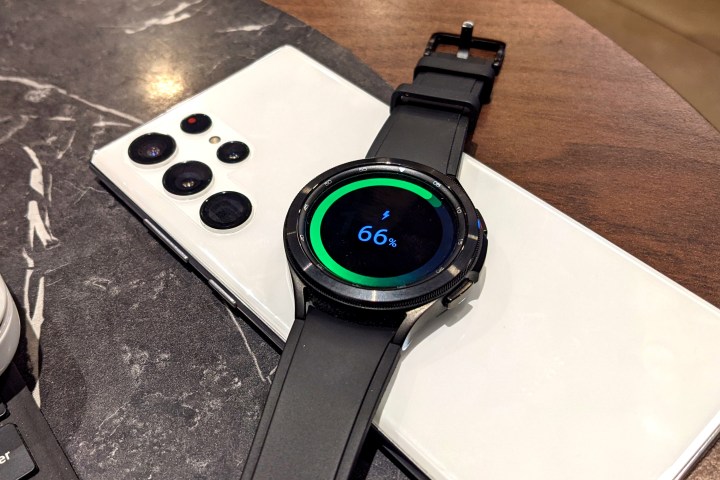
The situation is the same with wireless charging accessories. When I put the Galaxy Watch 4 on a Samsung charging mat, it was charging just fine. However, there was no charge transfer when I put the watch on a third-party Qi-certified charging mat.
Another woeful generation
The Samsung Galaxy Watch 5 continues that frustrating trend of non-compatibility. Just like the Galaxy Watch 4, the Galaxy Watch 5 series is also limited to WPC-based wireless charging. Further, Samsung won’t explain how it is technically different from the universal Qi wireless charging standard.
If you look at the specifications sheet of any Samsung audio wearable, like the Galaxy Buds 2, it mentions “Qi-certified wireless charging.” As expected, the audio wearable can be charged using any third-party Qi-certified wireless charging device.
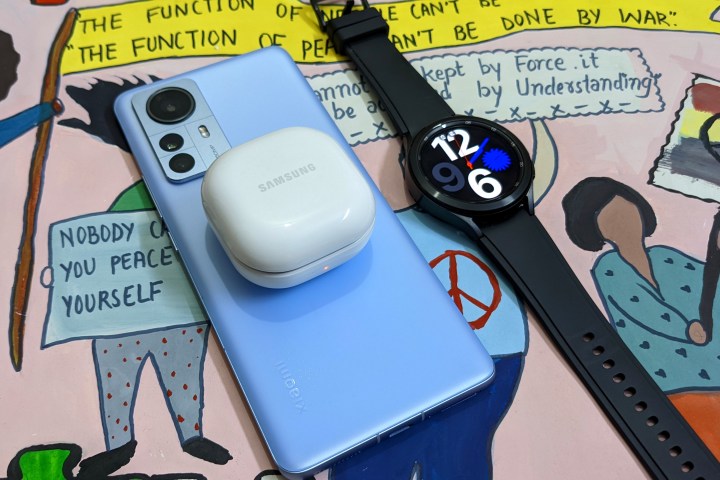
Even your non-Samsung phone with wireless power-sharing support will do the job. I charged my Galaxy Buds with the Galaxy S22 Ultra, Xiaomi 12 Pro, and the OnePlus 10 Pro — and everything was fine. These issues only happen when you substitute Samsung’s audio wearable with its wrist-born wearable.
Why limit the Galaxy Watch 5?
Honestly, I have no clue. An official Samsung explainer page for Wireless PowerShare only mentions that it “may not work with certain accessories, covers, other brand devices.” Why that’s the case remains a mystery.

In a separate official resource detailing compatibility for Wireless PowerShare, it is mentioned that this feature works with “most” Qi-certified devices. But the caveat follows soon. “This feature may not work with some cases, accessories, or other manufacturers’ devices.”
Here’s another support page that lays down the limitation, without any explanation, as you can see in the image below:
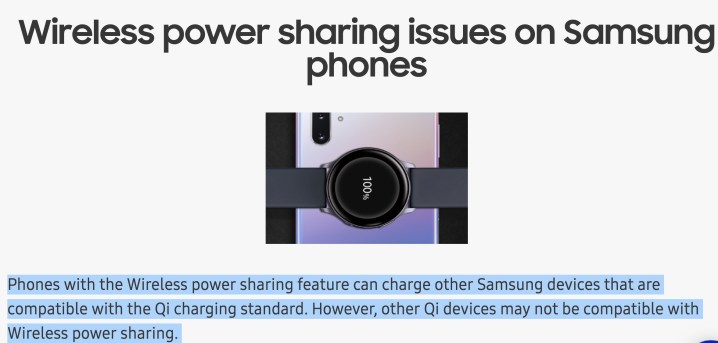
This old support page mentions that Wireless PowerShare is only available on “WPC Qi-certified devices.” Perhaps, this is the accurate answer, but Samsung is again shying away from explaining the technical details behind the limitation.
The only plausible explanation here is that Samsung put in some proprietary wireless charging tweaks to the Galaxy Watch lineup, ensuring that they can only be used by Samsung’s own gear or WPC-Qi certified devices. But the situation around third-party charging accessories is not crystal clear either.
Naturally, a lot of Galaxy smartwatch users aren’t too pleased about it.
The inexplicable blockade
A Samsung support page notes that “the Fast Wireless Charging function may be limited and may not work properly on fast wireless chargers” without the WPC(Qi) certification. However, there is more to the picture.
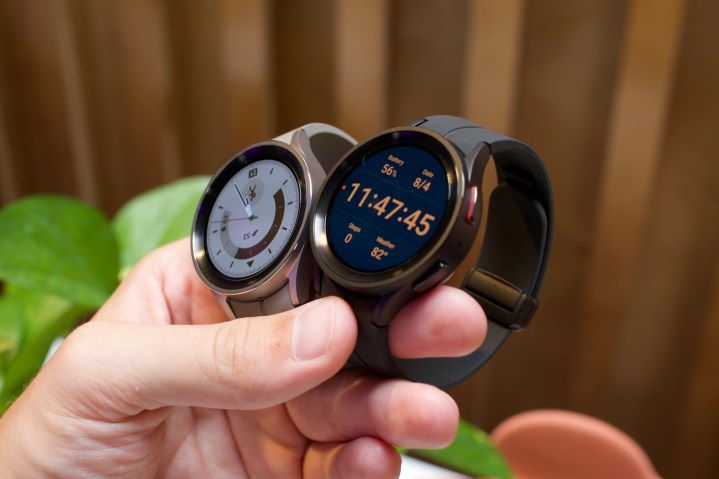
“Specifically, your charger should be Samsung Fast Wireless Charging certified in the WPC certification category and fast charging may be limited on non-verified chargers,” adds the support page. In a nutshell, your Qi wireless charging device must also be Samsung certified for it to properly juice up a Samsung gear without any risks.
For further clarity, Samsung follows up with this: “If you would like to use the Fast Wireless Charging feature on a non-Samsung Authorized wireless charger, confirm that your charger has WPC(Qi) certification and Samsung Wireless Fast Certification before use.”
There is no official explanation regarding the hazards of using a third-party Qi-certified charger and why they won’t play well with smartwatches like the Galaxy Watch 5. For now, I can only think of it as an Apple-esque restriction to boost the sale of one’s own accessories and keep users locked to an ecosystem.
Apple’s no different, but…
If you think Samsung is the only brand that locks its smartwatch behind an odd restriction, look no further than the Apple Watch. It is technically Qi-compatible but doesn’t universally support Qi-certified wireless charging gear.
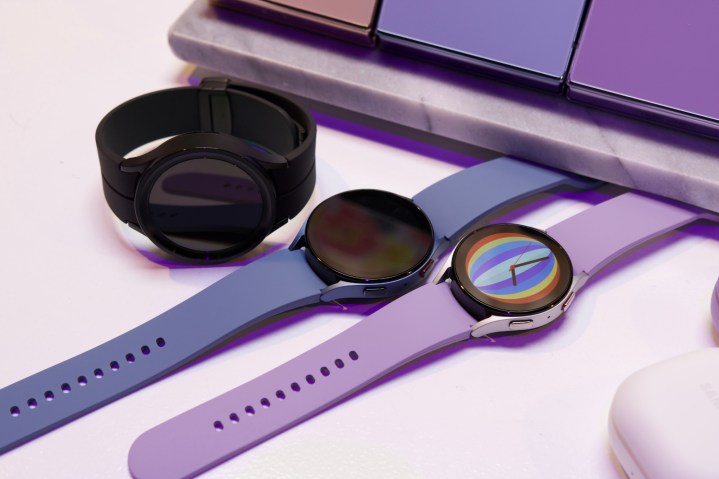
Just like Samsung, Apple’s approach is also skewed. Your AirPods and iPhone can be juiced up using a Qi charging mat, but not the Apple Watch. For the smartwatch, you either need an official Apple charger or an Apple-certified wireless charger from brands like Belkin.
At the end of the day, Apple makes money, either from the sale of its own accessory or through royalty fees. Samsung also appears to be following in the same footsteps, but there’s a difference.
Unlike Apple, which has a flourishing “Made for Apple” program that has multiple brands making Apple-certified gear, Samsung is nowhere close to that diversity. For all the talk of a sustainable future, brands like Samsung and Apple just can’t get rid of problems that could’ve been solved years ago.
Forcing users to buy certified gear not only puts more stress on their wallets, but also adds to the e-waste problem. The Galaxy Watch 5 is yet another missed opportunity — one that turns a convenient feature into a shameless cash-grab with a frustrating outcome for users.
Editors’ Recommendations

